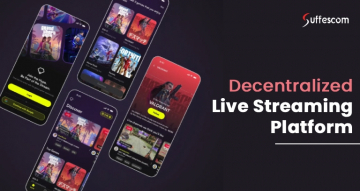How Much Does It Cost To Build a Loan App?

Rapid innovation in the financial sectors and growing demand for mobile apps for quicker and on-demand services have revolutionized how lenders grant and serve loans. According to the latest reports, the digital lending platform market size is expected to grow to $ 34.6 billion in 2028 at a compound annual rate( CAGR) of 22.1%.
Therefore, if you own a financial institution, organize a bank, or run a business, you might have thought of building a loan lending app. The one question that might have come up in your mind is, “ How Much Does It Cost To Build a Loan App?” right? This blog gives the complete breakdown of loan app development costs. Let us start reading it now!
Launch your Loan Lending app with Suffescom!
Partner with a top-notch loan app development company and build a robust app that streamlines the loan lending process and boosts profits.
Factors Affecting Loan App Development Cost
The estimated loan lending app development cost is $10,000 to $20,000. However, the factors below define its price. Review them to get the complete breakdown.
1. App Features and Functionality
The features of an app define its functionality for long-term operability. Developing a loan lending app with limited features, such as a loan application, has a lower development cost. In contrast, creating a robust and feature-rich app with advanced technological integrations costs more than a simple one.
2. Design User-Friendly Interface
Creating a seamless and intuitive interface is crucial to grabbing user attention and engagement. However, developing a visually attractive loan lending app requires precise icon placement, a consistent colour scheme according to brand niche, straightforward typography, and multiple animations. All these elements require a significant amount of money, which increases the overall development cost.
3. Back-end & Front-end Development
A loan lending app is a platform where users conduct sensitive transactions, making robust backend development essential. In this step, developers integrate APIs, server infrastructure, and database architecture to process secure transactions and handle real-time data, subsequently increasing the development cost.
4. Incorporating Security Features
A loan lending app needs robust security features to safeguard financial transactions and build credibility. However, implementing security features like biometric logins, fraud-detection systems, and two-factor authentication requires additional costs, increasing the app's development costs.
5. Industrial and Regulatory Compliance
The next factor that affects the loan lending app development cost is compliance with industrial and regulatory regulations. Anti-money laundering, consumer protection, and adherence to data privacy laws like GDPR( General Data Protection Regulation) are essential to running the application uninterruptedly. However, compliance with these laws requires regular audits and potential changes, which increases the overall development cost.
6. Third-Party Service Integrations
The loan lending app's integration with third-party services like multiple payment gateways and communication tools enhances its functionality. Still, licensing fees are added to maintain smooth interaction with these systems, increasing the overall cost.
7. Experience of the Development Team
Developing a robust, scalable, and efficient loan lending app is impossible without hiring a prominent loan app development company. They have a proficient team of developers, designers, and testers, who use an agile approach to use the top-notch loan lending app. The company may charge relatively higher, but their results are worthwhile.
8. Tech Stack Used in the Development
A tech stack defines the app's features, performance, security, sustainability, and compatibility. Therefore, choosing a robust set of tools and technologies to build a loan lending app is essential. Below is a basic breakdown of the tech stack used to develop the app. This might help you understand the exact cost of the app's development.
| Type | Tools/ Technologies |
| Front-end | HTML5, CSS4, React, TypeScript, |
| Back-end | Ruby on Rails, Node.JS and Django |
| Database | PostgreSQL, MongoDB and MySQL |
| Communication API integrations | Twilio |
| Security and Authentication | OAuth or JWT, |
| Detailed analytics and reports | Google Analytics and Mixpanel |
| Payment Gateways Integrations | Stripe or PayPal, Square, and Razorpay |
9. Choice of the Deployment Platform
The next factor is the choice of the deployment platform, which affects the loan lending app development cost. Developing an app for multiple platforms requires separate codebases, which require additional development time and costs. Moreover, each platform has specific requirements that the development team must follow, adding to the total development cost.
10. Testing and Quality Analysis
Comprehensive testing and verification are crucial to running a loan lending app smoothly and securely. Whether you hire quality assurance testers to identify or document issues or use automated tools for bug tracking, both have their costs, adding to the overall development cost of the loan app.
Transform Your Financial Services with a Scalable Loan Lending app
Suffescom’s proficient developers have a deep understanding of advanced technologies to build feature-rich and scalable loan apps to revolutionize your loan lending services.
Key Features of the Loan App Affecting its Development Cost
Below is a list of alluring features that might answer your question,” How much Does It Cost To Build a Loan App?” Check it out now!
For Admin
User Management
The app includes features like KYC verification and uses Firebase and OAuth authentication APIs, which help the admin manage user profiles and monitor their real-time activities to reduce fraud risk.
Data Analytics and Reports
Data analytics tools like Power BI and Mixpanel API provide detailed insights into user behavior and monitor financial trends, helping admins make informed decisions.
Content Management Systems (CMS)
The incorporated WordPress API or custom-built CMS allows the admin to regularly update the app’s content. They can edit loan terms and FAQs to ensure users get updated information about terms and loan policies.
Push Notification Management
Firebase Cloud Messaging( FCM) and push notifications allow the admin to schedule notifications for new offers, updates, and promotional alerts. This reduces missed payments and boosts user engagement.
App Security Setting
The admin can change the app’s security settings by configuring encryption, access controls, and activity logs to protect user data and transactions.
Dispute Resolution Tools
Zendesk and Twilio API help users submit their disputes within the app. The app also allows the admin to integrate a dispute ticketing system to improve user compliance and satisfaction.
For Borrower
Loan Comparison
The app allows borrowers to compare various available loan options based on interest rates, terms, and conditions to choose the most suitable one.
In-App Payment Feature
The borrowers can make repayments directly within the app from multiple payment options like UPI, net banking, wallets, etc., providing convenience.
In-app chat and Call Support
The app integrates Twilio and the Agora API to offer real-time chat and schedule call options, allowing borrowers to quickly contact customer support.
Bank Account Integration
The integrated Plaid and Yodlee APIs allow borrowers to link their bank accounts with the app, enabling faster and more secure loan disbursal and repayment transactions.
Repayment Schedule
The app includes a backend scheduler and Google Calendar API, which help borrowers reschedule repayment timelines and stay on track.
Payment Due Notifications
To reduce default risks, the app users push notifications and Twilio API to notify customers about upcoming payments through email or SMS.
For Lender
Manage Customer Profile KYC
The loan lending apps undergo AI-powered customer profile KYC processes to verify borrower identity and reduce fraudulent activities.
Risk Assessment Tools
The Loan app uses AI algorithms to generate credit scores and streamline the evaluation of borrowers' creditworthiness to predict any risks.
Loan Portfolio Management
Microsoft Azure and AWS APIs track loan performance and repayments. It offers real-time updates and financial insights to optimize loan management and profitability.
Advanced Integrations Affecting the Loan App Development Cost
The addition of advanced integrations undoubtedly enhances the functionality of the loan app, but it also increases its development cost. Below is the list of the advanced technologies that can increase the development cost of the loan lending app.
1. Integration with Digital Wallets
Integrating a digital wallet with the loan app streamlines the loan lending process and enhances user experience. It lets the borrower apply for the loan, get instant approval, and manage disbursement in a centralized place, reducing the loan processing price. The system also sends automatic repayment reminders to remind borrowers of payments and improve their creditworthiness. However, integrating this system increases the complexity of the development process, increasing its cost.
2. Big Data Analytics:
Big data integrations with loan apps analyze large user data sets to identify their behavior patterns, loan, repayment, and market trends. They also use machine-learning algorithms that help optimize approval rates and reduce credit risks. However, this process requires investment in data processing infrastructure and expertise in analytics algorithms, which adds to the total development cost.
3. Loan Risk Assessment
The loan lending app uses APIs like Experian, TensorFlow, and machine learning algorithms to analyze borrower data, such as credit history, previous activity, and transaction history, to evaluate credit scores and predict default risks. However, this requires developing an AI model and integrating it with credit bureaus, adding complexity and cost to the development process.
4. Biometric Authentication
A loan lending app handles sensitive user data and other credentials. Therefore, integrating biometric authentication, such as facial or fingerprint recognition, fosters a secure user experience and reduces fraud or unauthorized access. However, integrating the biometric SDKs requires additional testing, which increases the loan lending app development cost.
5. Multiple Repayment Options
Integrating multiple repayment options allows borrowers to pay their entire loan amount with charged interest in numerous ways. They can pay through UPI, credit cards, bank transfers, or digital wallets. However, incorporating these features requires additional integrations of APIs like Paytm SDK, Razorpay, and Stripe, affecting the total development cost.
6. Smart Contracts
Smart contracts are self-executing contracts with terms written directly into code that automates the loan agreement, disbursement, and repayments based on predefined conditions. Developers write, test, and deploy the secure code on the blockchain platforms, ensuring that contracts work as expected without any errors. This process involves security complexities and compliance with legal standards, adding to the overall development cost.
Build Your Loan Lending App Today!
Start your Journey with Suffescom and build a budget-friendly yet robust loan app that streamlines your loan lending services and enhances user engagement.
Hidden Costs to Consider When Loan App Development
Some factors aren't immediately apparent but appear once the app is launched, bringing hidden costs to the development process. Below is a list of the factors that affect the overall budget of loan app development.
1. App Maintenance and Improvement
The job doesn't end here; the app needs ongoing maintenance and improvement to run securely and smoothly. This process includes updating servers and operating systems and fixing bugs to enhance performance and improve user experience. All these procedures also add to the overall development cost of the loan lending app.
2. Hosting and Server Costs
The app hosting process provides the necessary infrastructure to deploy, run, and manage the app's server-side components. Incorporating platforms like AWS Amplify, Google Cloud, and Firebase provides scalable solutions but increases development costs. The hosting fee is charged based on storage capacity, user interaction, and server usage.
3. App Marketing and User Acquisition
Promotion and marketing of an application are crucial to increasing user engagement and generating revenue. The loan lending app development cost includes advertisement costs, such as pay-per-click ads and SEO.
4. Legal Documentation and License Costs
Compliance with relevant regulations like DSS, GDPR, and local financial laws is essential for legal operations, which adds to the development cost. Additionally, the recurring licensing fee for third-party integrations like credit scoring and fraud detection increases the overall pricing.
Why Choose Suffescom to Develop Loan Lending Apps?
Partner with the leading fintech mobile app development company, Suffescom, to achieve guaranteed success. We have 13+ years of industrial experience with a proficient team of developers, designers, and testers. Our team closely understands clients' requirements and uses an agile approach to build customer-oriented solutions. Contact us to streamline your financial business and boost profitability for continued success and growth.
Frequently Asked Questions
How Much Does It Cost To Build a Loan App?
The estimated development cost of a loan lending app range between $10000 to $20000. However, the value increases or decreases according to the app's complexity, features, third-party integrations, launching platform, etc.
What are the different types of Loan lending apps?
There are various loan lending apps, including student loan apps, personal loan apps, and peer-to-peer lending apps.
Can we integrate gamification with the loan lending app?
Yes. We can integrate gamification elements such as badges, leaderboards, and rewards to make the app more enjoyable and interactive.
Which companies are getting the most profit out of loan lending apps?
The companies that get the most profit out of loan lending apps are banks, financial institutions, etc.







